headlamp CHEVROLET COBALT 2007 1.G User Guide
[x] Cancel search | Manufacturer: CHEVROLET, Model Year: 2007, Model line: COBALT, Model: CHEVROLET COBALT 2007 1.GPages: 450, PDF Size: 2.48 MB
Page 156 of 450
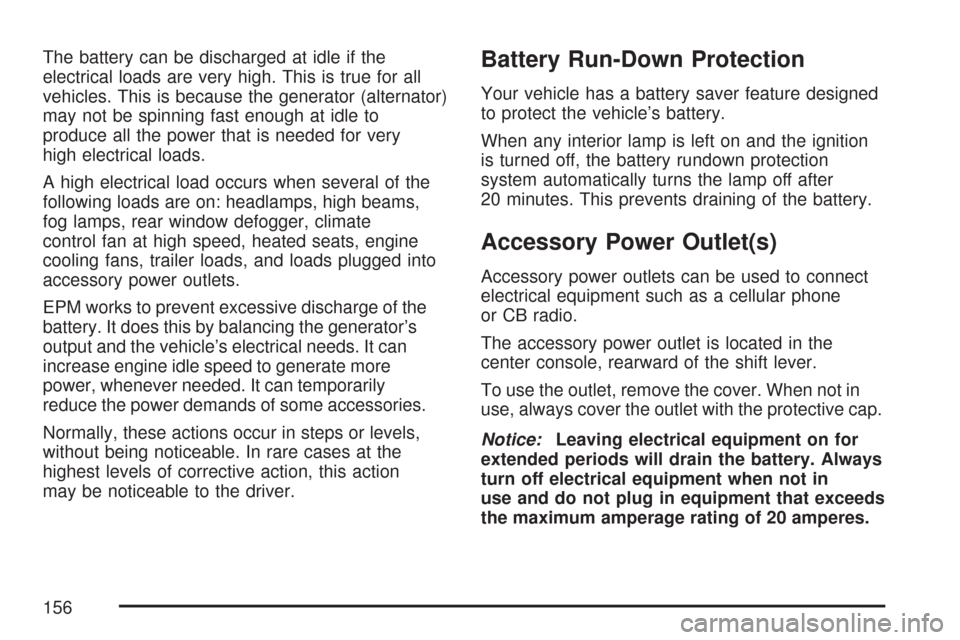
The battery can be discharged at idle if the
electrical loads are very high. This is true for all
vehicles. This is because the generator (alternator)
may not be spinning fast enough at idle to
produce all the power that is needed for very
high electrical loads.
A high electrical load occurs when several of the
following loads are on: headlamps, high beams,
fog lamps, rear window defogger, climate
control fan at high speed, heated seats, engine
cooling fans, trailer loads, and loads plugged into
accessory power outlets.
EPM works to prevent excessive discharge of the
battery. It does this by balancing the generator’s
output and the vehicle’s electrical needs. It can
increase engine idle speed to generate more
power, whenever needed. It can temporarily
reduce the power demands of some accessories.
Normally, these actions occur in steps or levels,
without being noticeable. In rare cases at the
highest levels of corrective action, this action
may be noticeable to the driver.Battery Run-Down Protection
Your vehicle has a battery saver feature designed
to protect the vehicle’s battery.
When any interior lamp is left on and the ignition
is turned off, the battery rundown protection
system automatically turns the lamp off after
20 minutes. This prevents draining of the battery.
Accessory Power Outlet(s)
Accessory power outlets can be used to connect
electrical equipment such as a cellular phone
or CB radio.
The accessory power outlet is located in the
center console, rearward of the shift lever.
To use the outlet, remove the cover. When not in
use, always cover the outlet with the protective cap.
Notice:Leaving electrical equipment on for
extended periods will drain the battery. Always
turn off electrical equipment when not in
use and do not plug in equipment that exceeds
the maximum amperage rating of 20 amperes.
156
Page 179 of 450
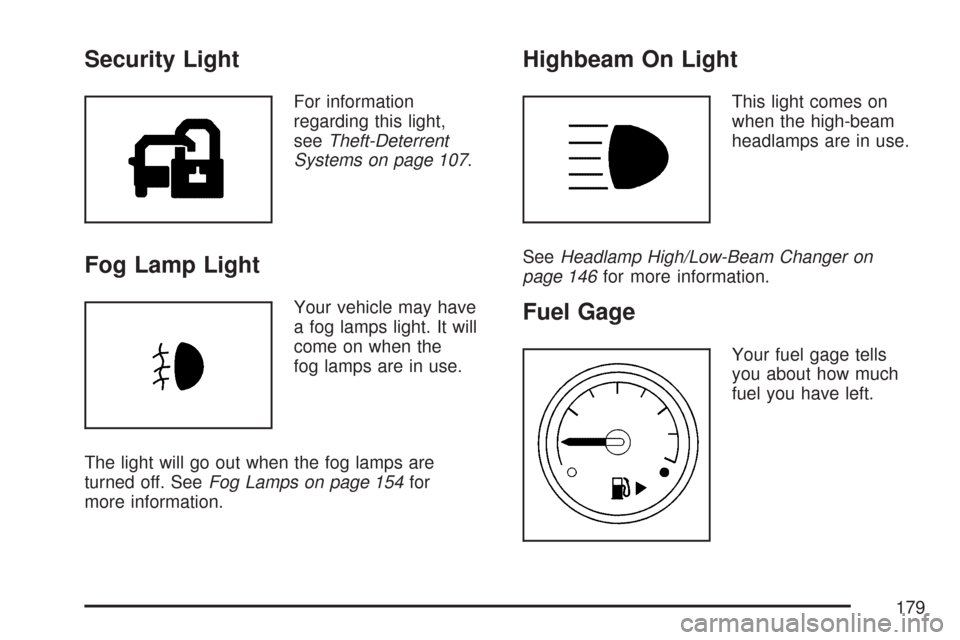
Security Light
For information
regarding this light,
seeTheft-Deterrent
Systems on page 107.
Fog Lamp Light
Your vehicle may have
a fog lamps light. It will
come on when the
fog lamps are in use.
The light will go out when the fog lamps are
turned off. SeeFog Lamps on page 154for
more information.
Highbeam On Light
This light comes on
when the high-beam
headlamps are in use.
SeeHeadlamp High/Low-Beam Changer on
page 146for more information.
Fuel Gage
Your fuel gage tells
you about how much
fuel you have left.
179
Page 184 of 450
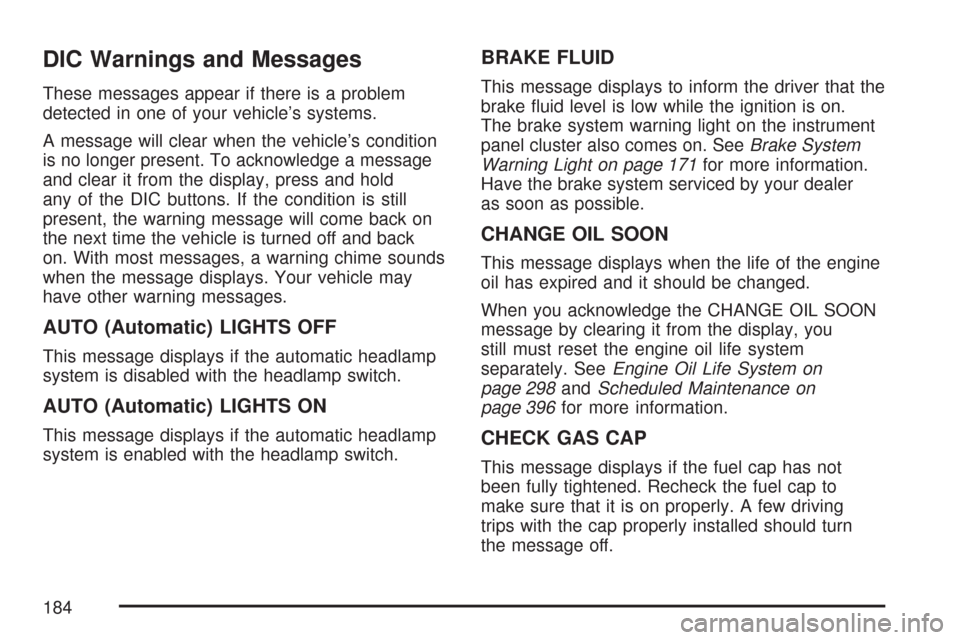
DIC Warnings and Messages
These messages appear if there is a problem
detected in one of your vehicle’s systems.
A message will clear when the vehicle’s condition
is no longer present. To acknowledge a message
and clear it from the display, press and hold
any of the DIC buttons. If the condition is still
present, the warning message will come back on
the next time the vehicle is turned off and back
on. With most messages, a warning chime sounds
when the message displays. Your vehicle may
have other warning messages.
AUTO (Automatic) LIGHTS OFF
This message displays if the automatic headlamp
system is disabled with the headlamp switch.
AUTO (Automatic) LIGHTS ON
This message displays if the automatic headlamp
system is enabled with the headlamp switch.
BRAKE FLUID
This message displays to inform the driver that the
brake �uid level is low while the ignition is on.
The brake system warning light on the instrument
panel cluster also comes on. SeeBrake System
Warning Light on page 171for more information.
Have the brake system serviced by your dealer
as soon as possible.
CHANGE OIL SOON
This message displays when the life of the engine
oil has expired and it should be changed.
When you acknowledge the CHANGE OIL SOON
message by clearing it from the display, you
still must reset the engine oil life system
separately. SeeEngine Oil Life System on
page 298andScheduled Maintenance on
page 396for more information.
CHECK GAS CAP
This message displays if the fuel cap has not
been fully tightened. Recheck the fuel cap to
make sure that it is on properly. A few driving
trips with the cap properly installed should turn
the message off.
184
Page 187 of 450
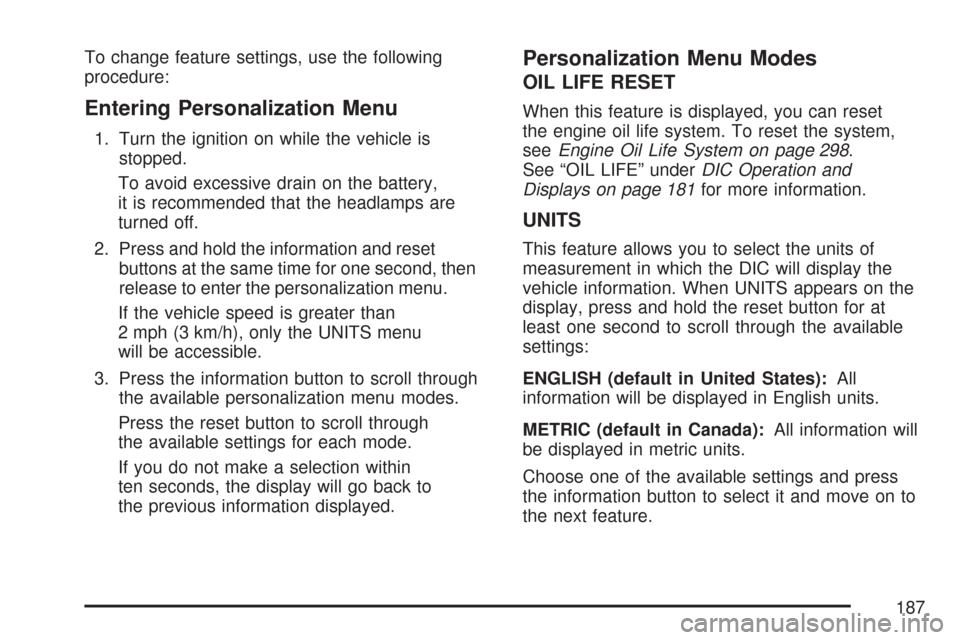
To change feature settings, use the following
procedure:
Entering Personalization Menu
1. Turn the ignition on while the vehicle is
stopped.
To avoid excessive drain on the battery,
it is recommended that the headlamps are
turned off.
2. Press and hold the information and reset
buttons at the same time for one second, then
release to enter the personalization menu.
If the vehicle speed is greater than
2 mph (3 km/h), only the UNITS menu
will be accessible.
3. Press the information button to scroll through
the available personalization menu modes.
Press the reset button to scroll through
the available settings for each mode.
If you do not make a selection within
ten seconds, the display will go back to
the previous information displayed.
Personalization Menu Modes
OIL LIFE RESET
When this feature is displayed, you can reset
the engine oil life system. To reset the system,
seeEngine Oil Life System on page 298.
See “OIL LIFE” underDIC Operation and
Displays on page 181for more information.
UNITS
This feature allows you to select the units of
measurement in which the DIC will display the
vehicle information. When UNITS appears on the
display, press and hold the reset button for at
least one second to scroll through the available
settings:
ENGLISH (default in United States):All
information will be displayed in English units.
METRIC (default in Canada):All information will
be displayed in metric units.
Choose one of the available settings and press
the information button to select it and move on to
the next feature.
187
Page 243 of 450
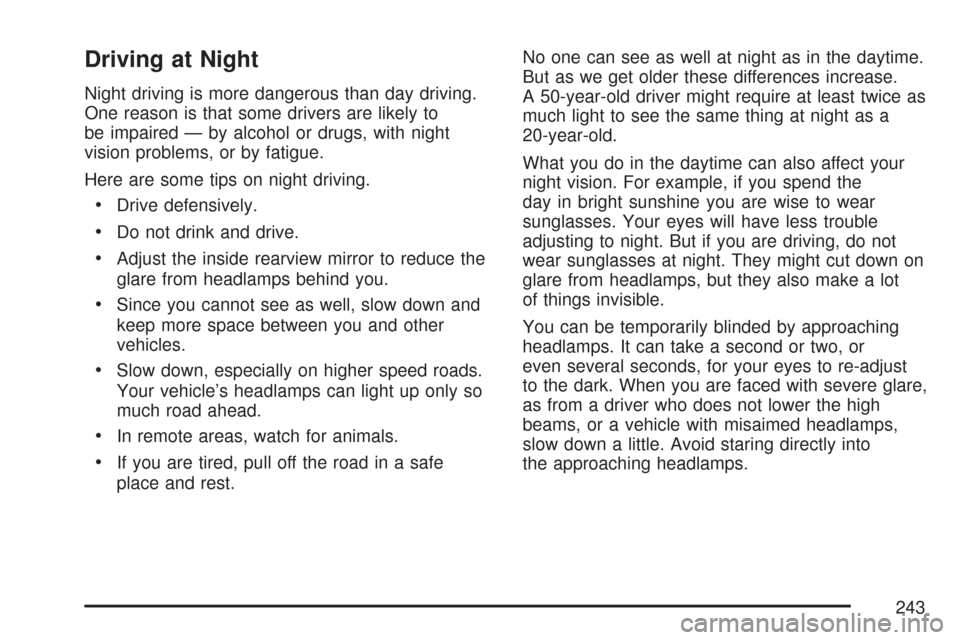
Driving at Night
Night driving is more dangerous than day driving.
One reason is that some drivers are likely to
be impaired — by alcohol or drugs, with night
vision problems, or by fatigue.
Here are some tips on night driving.
Drive defensively.
Do not drink and drive.
Adjust the inside rearview mirror to reduce the
glare from headlamps behind you.
Since you cannot see as well, slow down and
keep more space between you and other
vehicles.
Slow down, especially on higher speed roads.
Your vehicle’s headlamps can light up only so
much road ahead.
In remote areas, watch for animals.
If you are tired, pull off the road in a safe
place and rest.No one can see as well at night as in the daytime.
But as we get older these differences increase.
A 50-year-old driver might require at least twice as
much light to see the same thing at night as a
20-year-old.
What you do in the daytime can also affect your
night vision. For example, if you spend the
day in bright sunshine you are wise to wear
sunglasses. Your eyes will have less trouble
adjusting to night. But if you are driving, do not
wear sunglasses at night. They might cut down on
glare from headlamps, but they also make a lot
of things invisible.
You can be temporarily blinded by approaching
headlamps. It can take a second or two, or
even several seconds, for your eyes to re-adjust
to the dark. When you are faced with severe glare,
as from a driver who does not lower the high
beams, or a vehicle with misaimed headlamps,
slow down a little. Avoid staring directly into
the approaching headlamps.
243
Page 244 of 450

Keep the windshield and all the glass on your
vehicle clean — inside and out. Glare at night is
made much worse by dirt on the glass. Even
the inside of the glass can build up a �lm caused
by dust. Dirty glass makes lights dazzle and
�ash more than clean glass would, making the
pupils of your eyes contract repeatedly.
Remember that the headlamps light up far less of
a roadway when you are in a turn or curve.
Keep your eyes moving; that way, it is easier to
pick out dimly lighted objects. Just as the
headlamps should be checked regularly for proper
aim, so should your eyes be examined regularly.
Some drivers suffer from night blindness — the
inability to see in dim light — and are not even
aware of it.Driving in Rain and on Wet Roads
Rain and wet roads can mean driving trouble.
On a wet road, you cannot stop, accelerate, or turn
as well because your tire-to-road traction is not as
good as on dry roads. And, if your tires do not have
much tread left, you will get even less traction.
244
Page 258 of 450
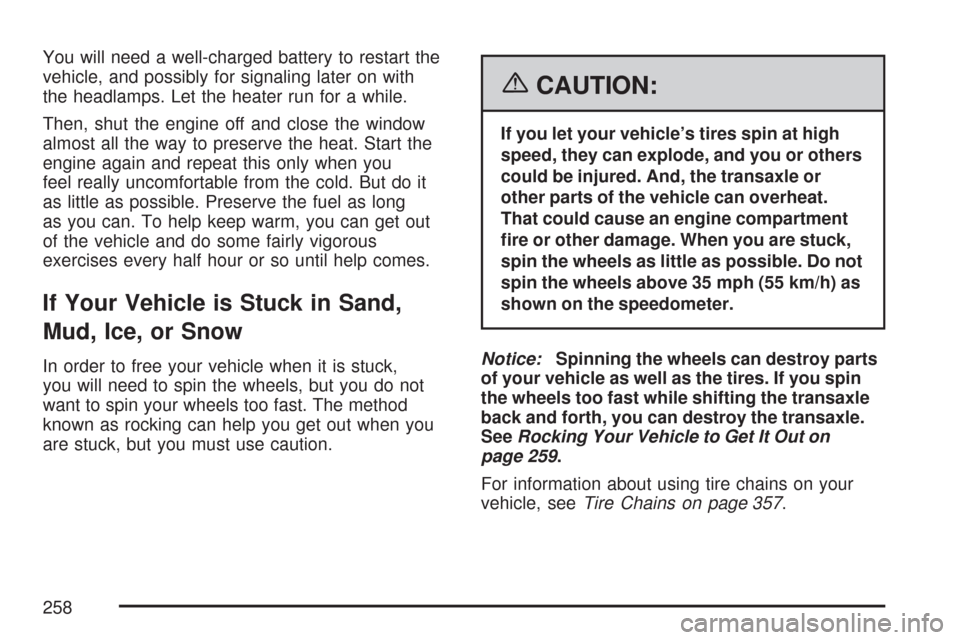
You will need a well-charged battery to restart the
vehicle, and possibly for signaling later on with
the headlamps. Let the heater run for a while.
Then, shut the engine off and close the window
almost all the way to preserve the heat. Start the
engine again and repeat this only when you
feel really uncomfortable from the cold. But do it
as little as possible. Preserve the fuel as long
as you can. To help keep warm, you can get out
of the vehicle and do some fairly vigorous
exercises every half hour or so until help comes.
If Your Vehicle is Stuck in Sand,
Mud, Ice, or Snow
In order to free your vehicle when it is stuck,
you will need to spin the wheels, but you do not
want to spin your wheels too fast. The method
known as rocking can help you get out when you
are stuck, but you must use caution.
{CAUTION:
If you let your vehicle’s tires spin at high
speed, they can explode, and you or others
could be injured. And, the transaxle or
other parts of the vehicle can overheat.
That could cause an engine compartment
�re or other damage. When you are stuck,
spin the wheels as little as possible. Do not
spin the wheels above 35 mph (55 km/h) as
shown on the speedometer.
Notice:Spinning the wheels can destroy parts
of your vehicle as well as the tires. If you spin
the wheels too fast while shifting the transaxle
back and forth, you can destroy the transaxle.
SeeRocking Your Vehicle to Get It Out on
page 259.
For information about using tire chains on your
vehicle, seeTire Chains on page 357.
258
Page 277 of 450
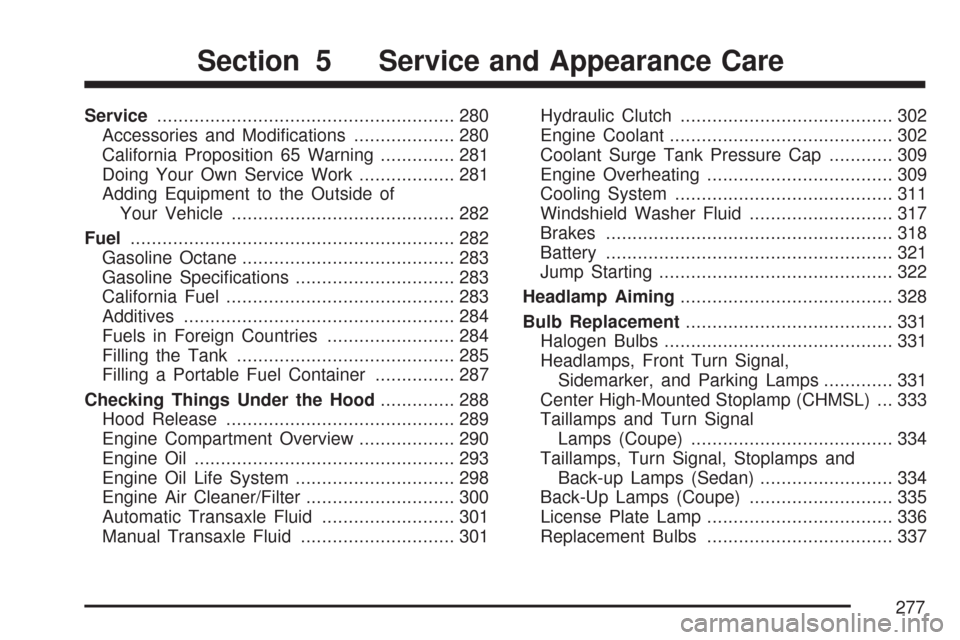
Service........................................................ 280
Accessories and Modi�cations................... 280
California Proposition 65 Warning.............. 281
Doing Your Own Service Work.................. 281
Adding Equipment to the Outside of
Your Vehicle.......................................... 282
Fuel............................................................. 282
Gasoline Octane........................................ 283
Gasoline Speci�cations.............................. 283
California Fuel........................................... 283
Additives................................................... 284
Fuels in Foreign Countries........................ 284
Filling the Tank......................................... 285
Filling a Portable Fuel Container............... 287
Checking Things Under the Hood.............. 288
Hood Release........................................... 289
Engine Compartment Overview.................. 290
Engine Oil................................................. 293
Engine Oil Life System.............................. 298
Engine Air Cleaner/Filter............................ 300
Automatic Transaxle Fluid......................... 301
Manual Transaxle Fluid............................. 301Hydraulic Clutch........................................ 302
Engine Coolant.......................................... 302
Coolant Surge Tank Pressure Cap............ 309
Engine Overheating................................... 309
Cooling System......................................... 311
Windshield Washer Fluid........................... 317
Brakes...................................................... 318
Battery...................................................... 321
Jump Starting............................................ 322
Headlamp Aiming........................................ 328
Bulb Replacement....................................... 331
Halogen Bulbs........................................... 331
Headlamps, Front Turn Signal,
Sidemarker, and Parking Lamps............. 331
Center High-Mounted Stoplamp (CHMSL) ... 333
Taillamps and Turn Signal
Lamps (Coupe)...................................... 334
Taillamps, Turn Signal, Stoplamps and
Back-up Lamps (Sedan)......................... 334
Back-Up Lamps (Coupe)........................... 335
License Plate Lamp................................... 336
Replacement Bulbs................................... 337
Section 5 Service and Appearance Care
277
Page 279 of 450
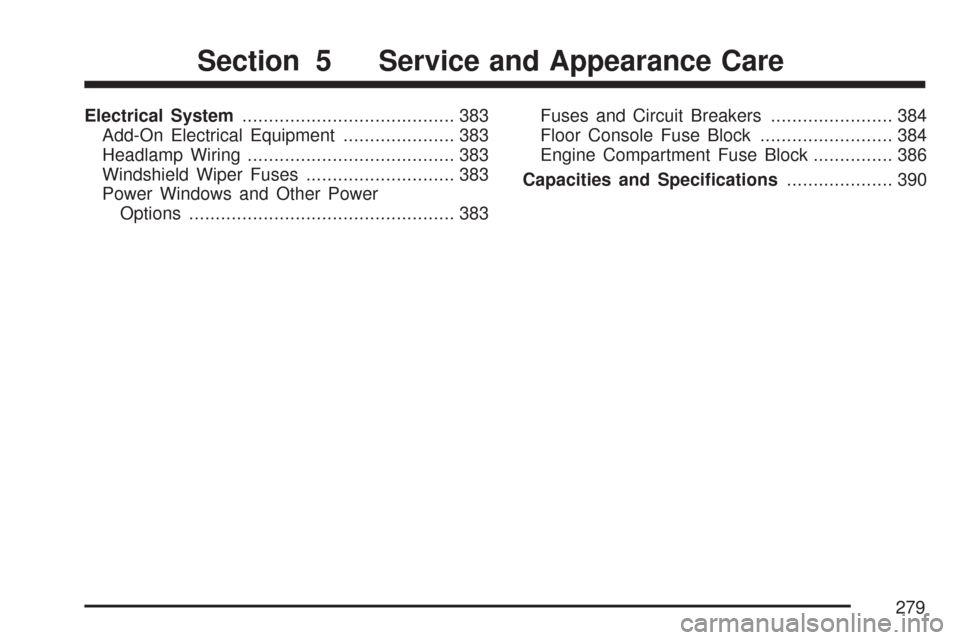
Electrical System........................................ 383
Add-On Electrical Equipment..................... 383
Headlamp Wiring....................................... 383
Windshield Wiper Fuses............................ 383
Power Windows and Other Power
Options.................................................. 383Fuses and Circuit Breakers....................... 384
Floor Console Fuse Block......................... 384
Engine Compartment Fuse Block............... 386
Capacities and Speci�cations.................... 390
Section 5 Service and Appearance Care
279
Page 328 of 450
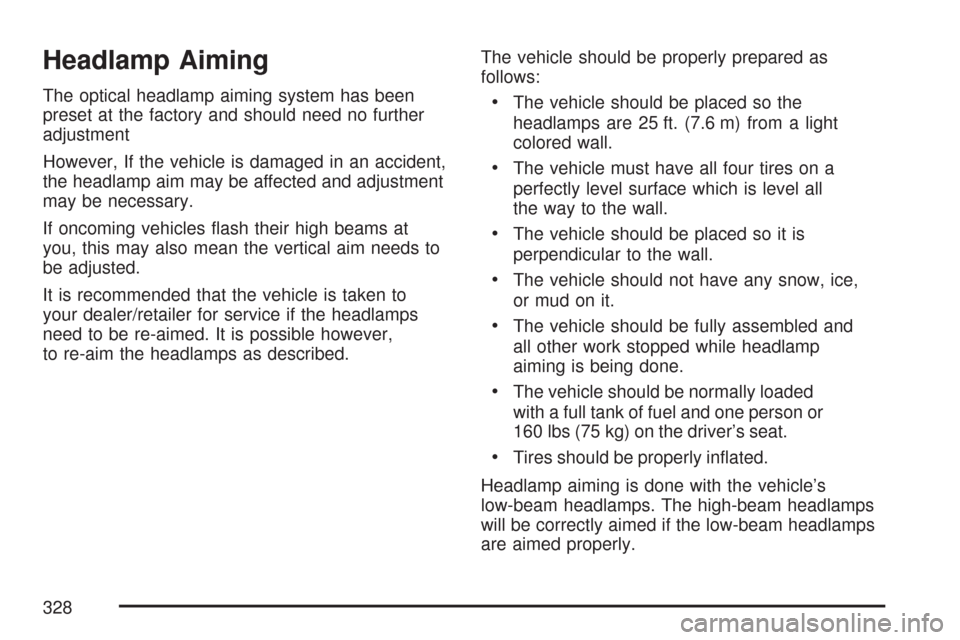
Headlamp Aiming
The optical headlamp aiming system has been
preset at the factory and should need no further
adjustment
However, If the vehicle is damaged in an accident,
the headlamp aim may be affected and adjustment
may be necessary.
If oncoming vehicles �ash their high beams at
you, this may also mean the vertical aim needs to
be adjusted.
It is recommended that the vehicle is taken to
your dealer/retailer for service if the headlamps
need to be re-aimed. It is possible however,
to re-aim the headlamps as described.The vehicle should be properly prepared as
follows:The vehicle should be placed so the
headlamps are 25 ft. (7.6 m) from a light
colored wall.
The vehicle must have all four tires on a
perfectly level surface which is level all
the way to the wall.
The vehicle should be placed so it is
perpendicular to the wall.
The vehicle should not have any snow, ice,
or mud on it.
The vehicle should be fully assembled and
all other work stopped while headlamp
aiming is being done.
The vehicle should be normally loaded
with a full tank of fuel and one person or
160 lbs (75 kg) on the driver’s seat.
Tires should be properly in�ated.
Headlamp aiming is done with the vehicle’s
low-beam headlamps. The high-beam headlamps
will be correctly aimed if the low-beam headlamps
are aimed properly.
328